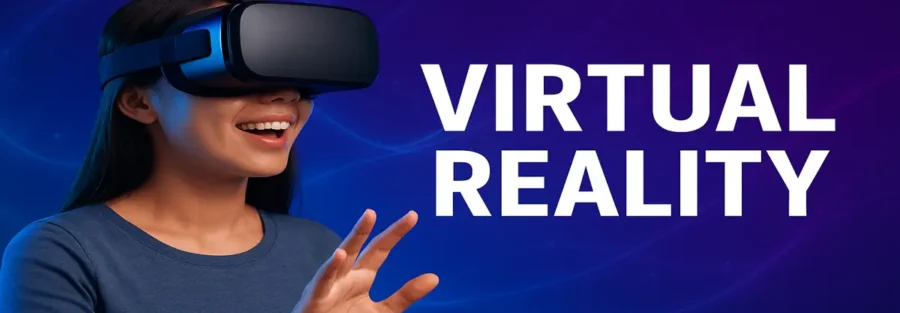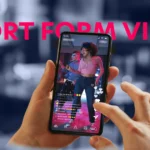Introduction
Virtual Reality, or VR, is a technology that allows us to go into a fake but real-feeling world. For this, we use VR headsets and sometimes controllers.
In this, we not only see things, but can also interact with them. Meaning, it feels like you are really present there.
Example: If you ride a roller coaster wearing a VR headset, you will feel like you are on a real ride, but you are safe in your room.
VR is now being used a lot in sports, studies, training, healthcare, and real estate. This technology is very helpful for learning and getting new experiences.
What is Virtual Reality?
Virtual Reality, or VR, is a technology that takes you to a fake but real-feeling digital world. For this, you use a VR headset and controllers.
In this world, you can see, hear, and interact with things as if you are really there.
Example: If you ride a roller coaster wearing a VR headset, you will feel like you are on a ride, but you are safe in your room.
VR is now being used in gaming, education, training, healthcare, and virtual tours. This technology helps you learn and feel new experiences.
Why Virtual Reality Matters?
Virtual Reality (VR) is important because it gives us a way to learn and experience something new, which is sometimes not possible in the real world.
- Realistic Experience: VR makes us feel real. Like you are in a ride, a jungle, or a classroom.
- Safe Environment: We can learn new things without any danger, like surgery practice or pilot training.
- Better Learning: VR helps in studies and training because we can see and feel things.
- Entertainment & Fun: VR makes gaming, movies, and virtual tours very fun and immersive.
- Innovative Technology: VR brings new solutions and ideas to businesses and industries.
In simple words, VR gives us a safe, fun, and learning digital experience, which makes our life and work easy and interesting.
Key Features of Virtual Reality
- Immersive Experience:
- VR takes you to a world where you feel like you are really there.
- 3D Environment:
- Everything in VR appears three-dimensional, which makes the experience feel more real.
- Interaction:
- You can touch, move, and interact with things in this world.
- Real-Time Response:
- As soon as you interact with something, VR responds immediately.
- Safe & Controlled Environment:
- You can experience new things without any danger, whether it is gaming or training.
- Wide Applications:
- VR is used in many fields like Education, Healthcare, Gaming, Real Estate, and Training.
Case studies: Virtual Reality Success Story
1. Walmart – VR in Employee Training
Walmart incorporated VR into its employee training process. Through this, new employees were given a virtual experience of store management, customer handling, and emergency situations.
The result: Training became more interactive and effective, and employees quickly learned to work in a real store.
2. IKEA – Virtual Furniture Experience
IKEA used VR to show its customers virtual furniture placement. Customers could see how the furniture would be placed in their home through a VR headset.
The result: Customers found it easier to shop, and IKEA’s sales and customer satisfaction increased.
3. Medical Field – Surgery Training
Many hospitals used VR to train doctors and surgeons for complex surgeries. Surgeons first practice through VR, and then work on real patients.
The result: Errors decreased and surgery outcomes improved.
4. Tourism Industry – Virtual Tours
Tourism companies used VR to give people a virtual travel experience. People can experience famous destinations like Paris, Egypt pyramids, and mountains without traveling.
Result: Tourists’ curiosity increased and bookings increased.
5. Gaming Industry – Oculus & VR Gaming
Oculus and other VR gaming platforms completely transformed gaming. Players were not just watching, but actively participating in the game world.
Result: Gaming experience became more immersive and fun, and the revenue of VR gaming industry is constantly growing.
How to Use Virtual Reality?
Using Virtual Reality has now become very easy and user-friendly. You just have to follow some basic steps.
1. Choose VR Device
First of all, you need a device for a VR experience. It can be:
VR Headset: like Oculus, HTC Vive, or PlayStation VR
Controllers: With which you can interact in the VR environment
Optional Accessories: Gloves, motion sensors, or a treadmill (for advanced experience)
2. Setup Device
Connect the VR headset and controllers.
Adjust the headset properly so that you get a comfortable and clear view.
Hold the controllers in your hand and calibrate them.
3. Install VR Software or App
For a VR experience, you need software or an app. This could be:
Gaming: Beat Saber, Half-Life: Alyx
Education: Virtual classrooms, lab simulations
Virtual Tours: Travel apps like Google Earth VR
4. Start the experience
Wear the headset and hold the controllers.
Open the VR app and follow the instructions.
You can now see, hear, and interact.
5. Follow the safety guidelines
Use VR only in open spaces.
Do not wear the headset for too long, take a break after 30-60 minutes.
If you feel motion sickness, rest immediately.
6. Enjoy and Learn
VR is not just for gaming. You can use it for:
Learning new skills
Travel and exploration
Professional training and simulations
Conclusions
Virtual Reality, or VR, is a technology that shows us a new and realistic world. Through this, we can see, hear, and experience things as if we are really there.
The biggest advantage of VR is that we can learn new things and get new experiences in a safe way. It helps a lot in many tasks like gaming, studies, training, healthcare, and virtual tours.
In simple words, VR is making our lives and the way of learning easy and fun, and its importance is going to increase further in the coming times.
FAQ
1. What is Virtual Reality (VR)?
Virtual Reality is a technology that lets you step into a digital world that feels real. Using a VR headset and controllers, you can see, hear, and even interact with this virtual world as if you are actually there.
2. Why is VR important?
VR is important because it allows you to experience things safely that might be impossible in real life. It is used in gaming, learning, training, healthcare, business, and virtual tours.
3. What do I need to use VR?
- A VR headset like Oculus, HTC Vive, or PlayStation VR
- Controllers to interact with the virtual world
- VR apps or software for gaming, education, or experiences
4. Is VR safe to use?
Yes, VR is safe if you use it in a clear, open space and take short breaks. Using it for too long may cause eye strain, dizziness, or motion sickness in some people.
5. Is VR only for gaming?
No. VR is not just for games. It is also used for learning, professional training, medical simulations, virtual tours, and business purposes.
6. Are there any side effects of VR?
Some people may feel dizzy, nauseous, or uncomfortable if used for long periods. It’s best to take breaks and use it safely.
Curious about smart transportation and digital growth? Head over to Digital Pracer’s blog and explore content that keeps you ahead of the curve!








